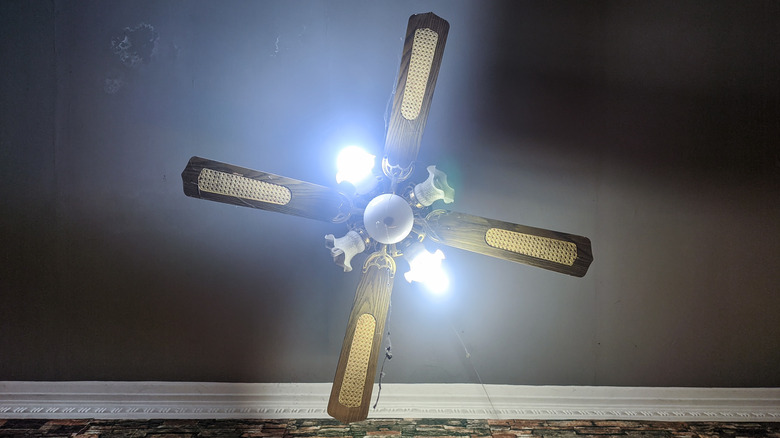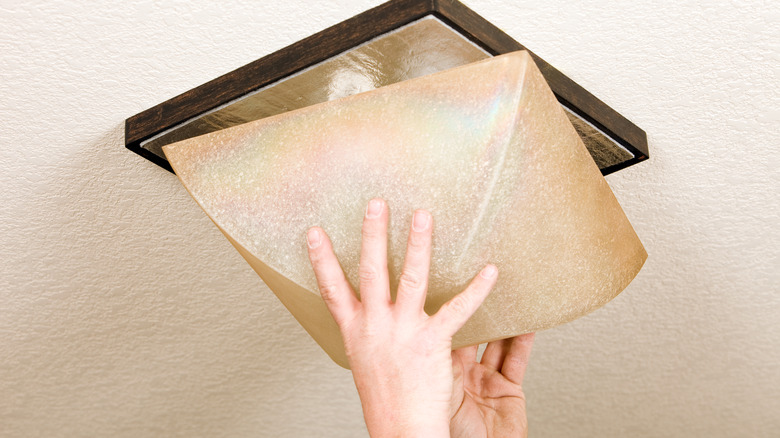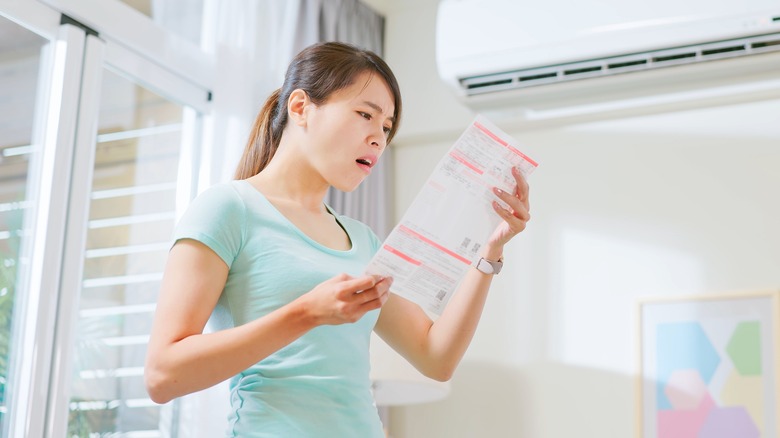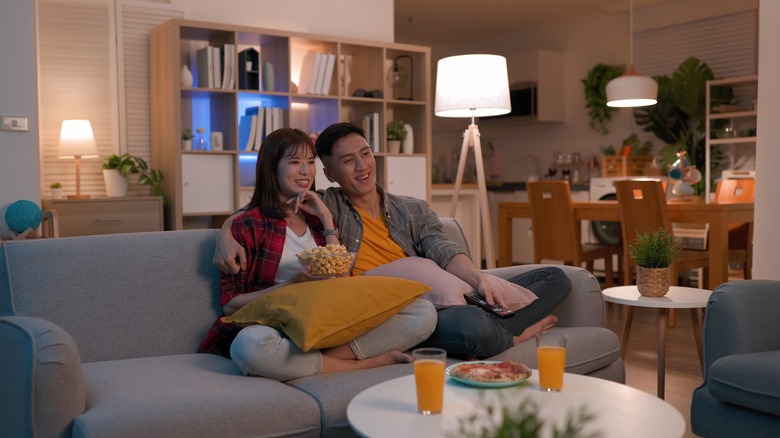Gen Zers And Millennials Are Right: The Big Light Is A Big Pain
When we're talking about the "big light," we don't mean the great ball of flaming plasma that's 91 million miles away from Earth. The big light is a humorous yet fitting name for a room's main central light source, usually a large globe light, ceiling fan light, or bright recessed lighting. When it's turned on, the big light floods the whole room with bright, unavoidable light. Some people find this light to be helpful and awakening, while others find rather assaulting to the senses — particularly people in the younger generations. There are thousands of TikTok videos created by Gen Zers and Millenials, demonstrating the cold, glaring effects of their home's big light in contrast to warmer, softer lamp lights. The general conclusion? Most creators and commenters agree that the "big light has no vibe."
Gen Zers and Millenials may have a special dislike towards the big light, but switching away from this glaring home feature can benefit people of all ages, and in more ways than you might expect. In fact, critics of the big light make some strong points, and their arguments are largely backed up by interior designers, energy conservationists, and even healthcare professionals. Here's why the big light makes us cringe and all the better ways to light your home for health, wealth, and positive vibes.
The big light can drain the mood
Since it started as a comment on a TikTok video, the saying, "big light has no vibe," has caught on like wildfire because it perfectly describes the cold and "vibeless" mood that the big light creates in a room. When it comes to social situations, a big light can feel like an interrogation lamp. On the other hand, soft, warm lighting in living rooms and bedrooms makes people feel more relaxed and social. "The lower-key ambiance that comes with fairy lights and lamps creates a cozy intimacy, inspiring a sense of security and wellbeing," interiors therapist and feng shui expert Suzanne Roynan explains to Stylist. "This makes a world of difference when it's time to wind down to spend quality time alone or with someone you love."
Speaking of romance, the big light is bad for date night. Of course, dimming the lights is hardly a new concept, but turning off the big light is key to setting a good mood, especially when you're hoping to get closer to a romantic partner. Frankly, it's hard to get physically or emotionally comfortable under a big light, which can make laying on your living room sofa feel like you're laying on an operating table. "Let's be honest, it's rare to feel amorous under the unflattering intensity of a ceiling light," Roynan adds. "Soft, muted lighting boosts the mood, heightens the senses and, in the right company, encourages feelings of passion and romance."
The big light can drain your health
Besides projecting a bad vibe, bright overhead lights can cause migraines, strain your eyes, impact your sleep, and mess with your hormones. As Dr. Mahmud Kara says in an interview with Reader's Digest publication The Healthy, "Studies have found that when light enters the eye, it can activate the same nerve cells in the brain that are active during a migraine attack, which may explain why overhead lights tend to exacerbate migraine attacks. Additionally, the big light is not a substitute for natural light. When we leave the big light on all day, we might forget to open our windows and experience some wholesome, natural sunlight, which elevates mood and is crucial for healthy vitamin D levels.
Even after you turn the big light off, its effects can haunt you into the night. "When light enters the eye, nerve signals are processed throughout the body. Therefore, exposure to overhead lights, especially very bright overhead lights, may cause you to feel more alert and unable to wind down for sleep," says Dr. Kara. Warm, ambient lighting in the evening also sets you up for successful sleep, and sunlight exposure during the day regulates your circadian rhythm. Besides making you feel sick, overhead lighting can also make you look sick, and not just by sabotaging your sleep. Big lights are generally unflattering, casting shadows that make you look ghoulish or tired. By contrast, lamps and ambient lights make your skin look smoother, warmer, and brighter.
The big light can drain your wallet
If emotional and physical well-being aren't enough for you to make the switch, the big light could also be wasting energy and your hard-earned money. Incandescent lamps are usually cheaper to use than incandescent ceiling lights, and task lighting options ensure that light only goes where you need it, instead of wasting energy to brighten the whole room. "Lamps will generally be cheaper to run than ceiling lights, as they are intended for close-up use and will commonly have a lower wattage," says energy expert Ben Gallizzi (via Metro), "A bright ceiling light for a large room would typically consume 10W, costing 56p [or 78 cents] to run eight hours a day for a week. Meanwhile, a bedside lamp with a 5W LED bulb would cost you 28p [or 35 cents] for the same period." However, LEDs are better than regular lightbulbs for overall energy consumption, no matter what fixture.
If you're building or remodeling a home and debating on how many "big lights" to add, consider implementing more lamps and ambient lighting instead. Light bulbs in both lamps and ceiling fixtures are bound to burn out eventually, but replacing the lightbulb in a lamp tends to be cheaper and much easier. Even when a lamp breaks completely, it's easy enough to unplug it and have it repaired or replaced. It's not nearly as easy to fix a broken or badly wired big light, or even just change the lightbulb.
Little lights are a big win
In summary, it's about time we all ditch the big light and opt for lighting solutions that are healthier, happier, and more affordable. If you're just now realizing that you have a big light problem in your home, making the switch to soft, cozy lamps can be easy and fun. For the best results, try to use lamps in a variety of styles. Gen Z member and TikTok user Ben Nelson (@_bennelson_) recommends starting with a main light source like a floor lamp, an ambient light source like a sunset lamp, and a decorative accent piece like a globe light. Remember to open your window blinds or curtains in the daytime to let in more natural, healthy (and free!) sunlight, and switch to lamps and ambient lights a few hours before bedtime.
If you already have an abundance of lamps in your home, but you're still struggling to make the space feel cozy, ensure that you're using warm lightbulbs; a bulb around the 2000 – 3000 Kelvin temperature range is ideal for a soft, cozy glow. Color-changing and dimmable lights can also give you better control over the mood and your energy usage. All that said, while it may be detrimental to good interior design, the big light isn't always bad. Save the big light for times when you actually need to illuminate the whole room, like when you're ready to start with your carpets when spring cleaning. And frankly, if you're going to defend the big light for daily use, you can at least swap for warm bulbs — or a more diffused light fixture.




